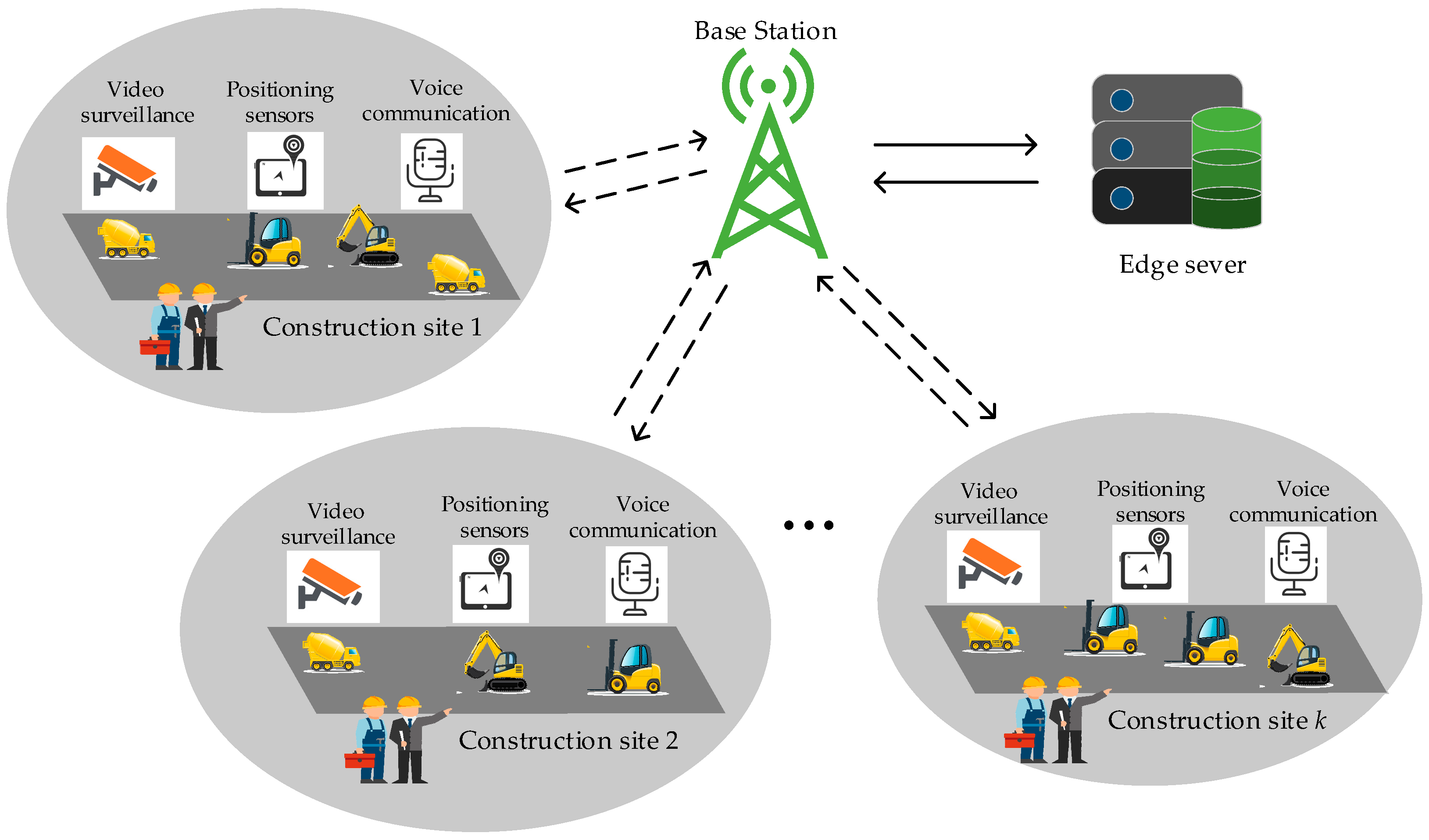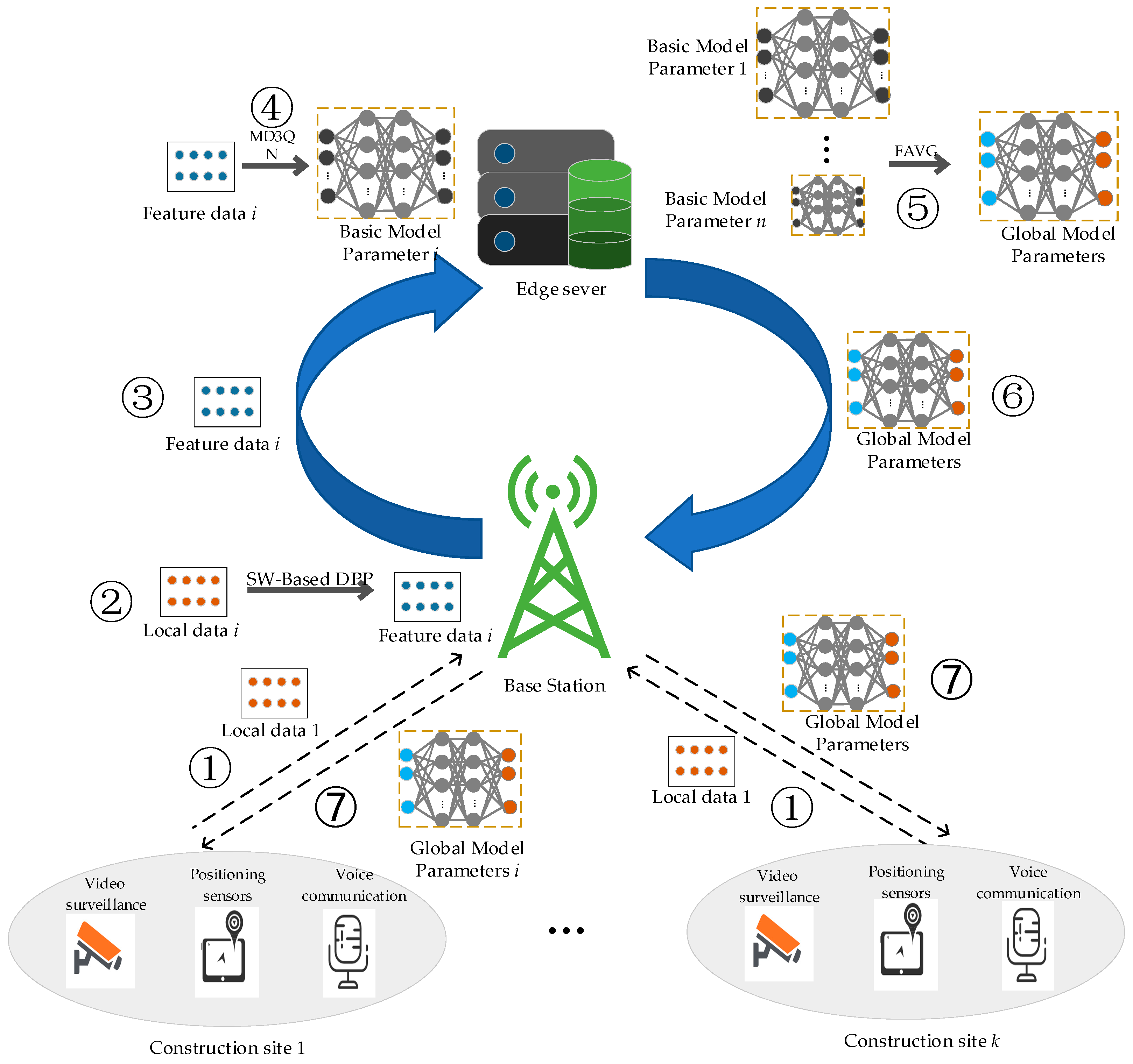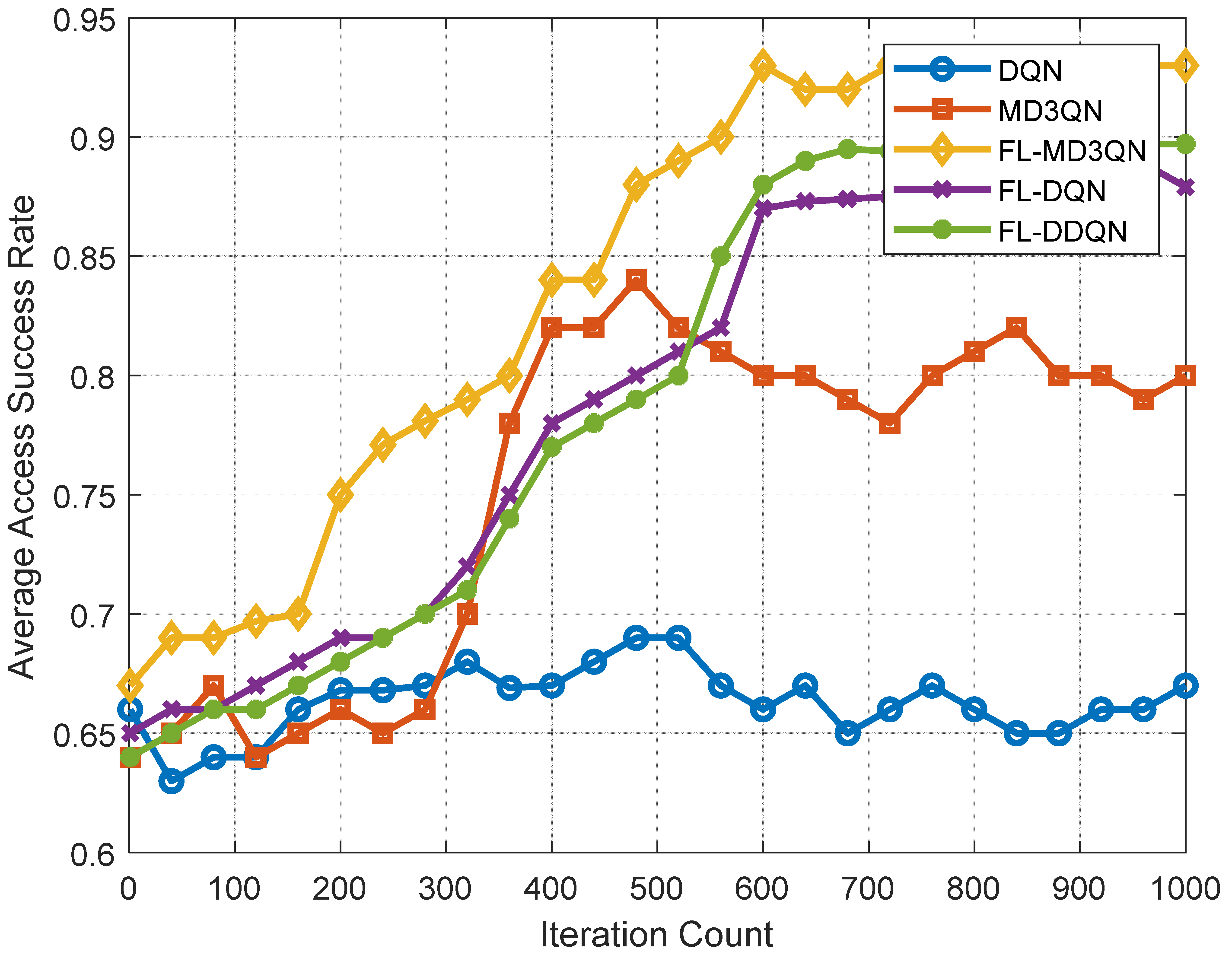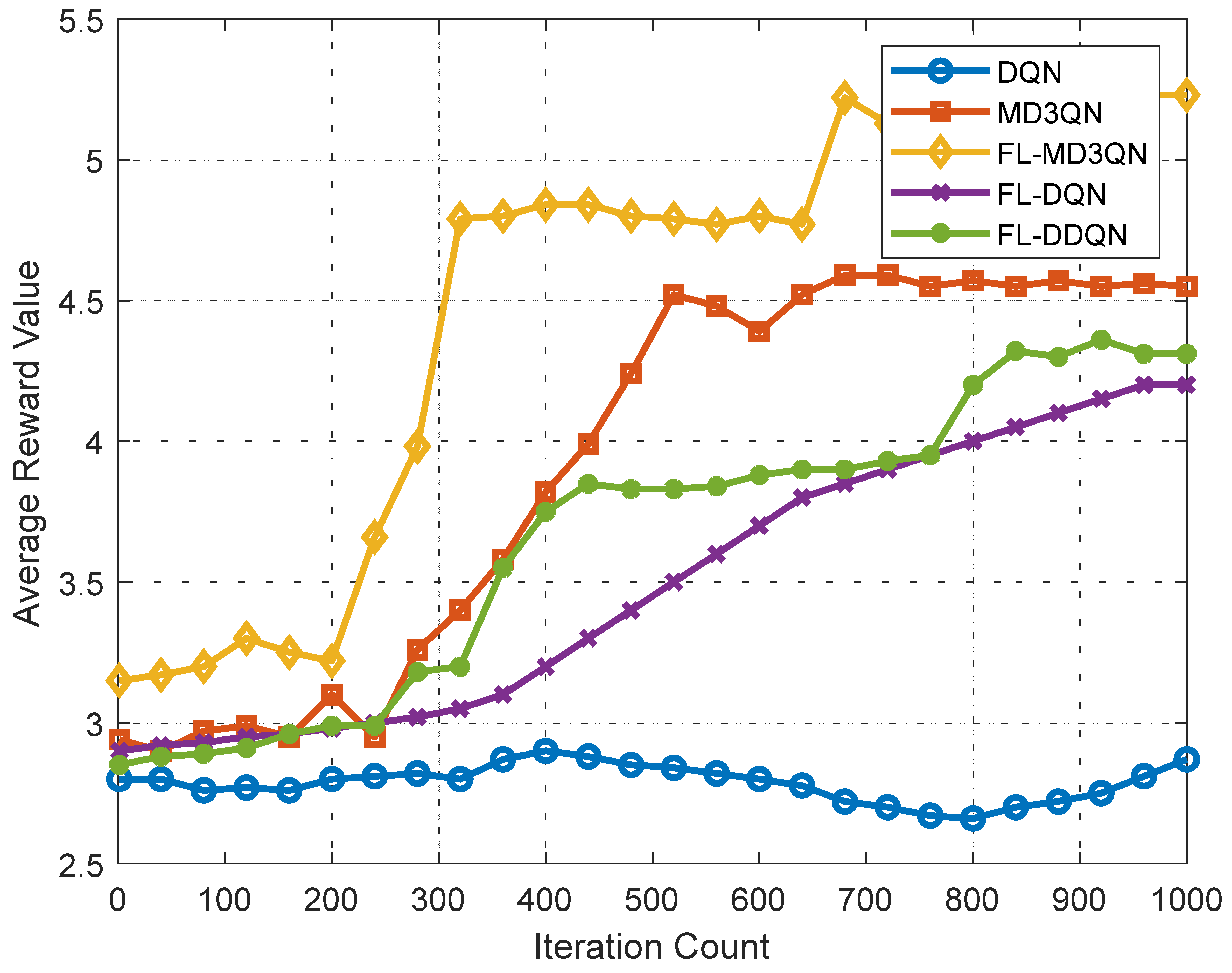FL-MD3QN-Based IoT Intelligent Access Algorithm for Smart Construction Sites
Abstract
:1. Introduction
- (1)
- This paper proposes an IoT intelligent access framework tailored for multi-site, multi-modal, and multi-user scenarios, innovatively constructing a three-objective optimization model aimed at maximizing data transmission rate, minimizing delay, and maximizing reliability. When aggregating model parameters using federated learning, a dynamic weighted aggregation mechanism is introduced, which adaptively adjusts weights based on data quality and communication stability at each site, ensuring privacy security while improving data aggregation efficiency.
- (2)
- The federated learning mechanism boasts a unique design in addressing user privacy risks. By integrating heterogeneous data from multiple sites, it enhances model generalization capability. Local models are trained at each site and aggregated to form a global model, adapting to varying communication demands.
- (3)
- A dynamic spectrum access strategy based on MD3QN is presented, featuring a shared base-layer mechanism in the MD3QN architecture that reduces parameter redundancy and improves computational efficiency. Meanwhile, a dual-network update strategy decouples action selection and evaluation, effectively mitigating the issue of overestimated Q-values. A business-adaptive reward function tailored to differentiated business characteristics optimizes spectrum access strategies for each scenario by assigning varying weights.
- (4)
- The FL-MD3QN algorithm exhibits significant advantages in performance. By integrating federated learning and optimizing reward function design, FL-MD3QN surpasses traditional algorithms in key metrics such as delay, transmission rate, access success rate, and bit error rate. Furthermore, its lightweight deployment on the Jetson AGX Xavier edge node further validates its scalability and practicality in real-world smart building scenarios.
2. Problem Description
- (1)
- Maximize data transmission rate.
- (2)
- Minimize data transmission delay.
- (3)
- Maximize reliability.
- (1)
- Bandwidth constraint:
- (2)
- Power constraint:
- (3)
- Processing capability constraint:
- (4)
- Total access time constraint:
- (5)
- BER constraint:
- (6)
- Transmission data association constraint:
3. FL-MD3QN-Based Intelligent Access
3.1. Data Preprocessing
| Algorithm 1: SW-Based DPP algorithm |
| 1: Input: L //*Raw IoT traffic file in pcap format 2: Output: csvs // CSV-formatted traffic dataset containing device ID, service type, extended transmission features, and basic traffic features 3: t1, t2, … ti ← SplitCap(L)// Split raw traffic by five-tuple information and remove non-target IoT device traffic 4: for ti in t do // ti: ith traffic file of target IoT devices 5: lists = rdp(ti)// Parse raw traffic using scapy library and save to lists 6: for list in lists do 7: File = open(“device.csv”,“w”)// Create CSV file to store traffic features 8: ARP, LLC, IP… = 0 //Initialize 26-dimensional feature values 9: ARP, LLC, IP… = list[ARP], list[LLC], list[IP]…// Extract 26-dimensional features 10: ARP, LLC, IP…→File //Write features to CSV file 11: File.close () 12: end for 13: csvs = csv1∪csv2∪csv3…∪csvi //Merge into initial IoT traffic dataset 14: end for 15: return csvs |
3.2. System Model
3.2.1. MD3QN Algorithm
3.2.2. FAVG Algorithm
| Algorithm 2: FAVG. B, E, η: Local minibatch size, epochs, and learning rate. |
| //FL execution on the edge server side 1: Initialize global model weights w0 2: for each communication round t = 1, 2,…, T do 3: Set user selection ratio C (0 < C ≤ 1) // C is the fraction of users selected per round 4: 5: Randomly select m users 6: for each site in parallel do 7: // Local training at user k based on global model wt 8: end for 9: // Aggregate local model updates (weighted average) // Sample count for user k; n: Total selected samples 10: end for // Definition of client update function Function ClientUpdate (k, wglobal): 11: Initialize local model 12: Fetch local dataset Pk with size nk 13: Partition Pk into batches of size B 14: for each local epoch i = 1, 2,…, E do 15: for each batch do 16: // Compute gradient and update parameters (gradient descent) 17: ∇ ← Compute gradient for batch b 18: w ← // η: Learning rate 19: end for 20: end for 21: Return updated model w to the edge server |
3.3. The Training and Deployment of the FL-MD3QN Network
4. Simulation and Analysis
4.1. Simulation Parameter Settings
4.2. Simulation Result Analysis
5. Conclusions and Future Work
5.1. Conclusions
5.2. Future Work
Author Contributions
Funding
Data Availability Statement
Conflicts of Interest
References
- Márquez-Sánchez, S.; Campero-Jurado, I.; Robles-Camarillo, D.; Rodríguez, S.; Corchado-Rodríguez, J.M. BeSafe B2.0 Smart Multisensory Platform for Safety in Workplaces. Sensors 2021, 21, 3372. [Google Scholar] [CrossRef] [PubMed]
- Liu, H.; Tian, N.; Song, D.-A.; Zhang, L. Digital Twin-Enabled Multi-Service Task Offloading in Vehicular Edge Computing Using Soft Actor-Critic. Electronics 2025, 14, 686. [Google Scholar] [CrossRef]
- Shaukat, K.; Luo, S.; Varadharajan, V. A novel deep learning-based approach for malware detection. Eng. Appl. Artif. Intell. 2023, 122, 106030. [Google Scholar] [CrossRef]
- Attajer, A.; Mecheri, B. Framework for Modeling the Propagation of Disturbances in Smart Construction Sites. In Proceedings of the 21st International Conference on Smart Business Technologies, Dijon, France, 9–11 July 2024; pp. 80–87. [Google Scholar]
- Manzoor, H.U.; Shabbir, A.; Chen, A.; Flynn, D.; Zoha, A. A Survey of Security Strategies in Federated Learning: Defending Models, Data, and Privacy. Future Internet 2024, 16, 374. [Google Scholar] [CrossRef]
- Sileikis, V.; Wang, W. Smart Contract for Relay Verification Collaboration Rewarding in NOMA Wireless Communication Networks. Electronics 2025, 14, 706. [Google Scholar] [CrossRef]
- Wu, J.; Qiu, Z.; Dai, M.; Bao, J.; Xu, X.; Cao, W. Distributed Sequential Detection for Cooperative Spectrum Sensing in Cognitive Internet of Things. Sensors 2024, 24, 688. [Google Scholar] [CrossRef]
- He, J.; Guo, S.; Pan, G.; Yang, Y.; Liu, D. Relay cooperation and outage analysis in cognitive radio networks with energy harvesting. IEEE Syst. J. 2016, 12, 2129–2140. [Google Scholar]
- Li, H.; Zhao, X. Throughput maximization with energy harvesting in UAV-assisted cognitive mobile relay networks. IEEE Trans. Cogn. Commun. Netw. 2020, 7, 197–209. [Google Scholar]
- Geirhofer, S.; Tong, L.; Sadler, B.M. Cognitive radios for dynamic spectrum access-dynamic spectrum access in the time domain: Modeling and exploiting white space. IEEE Commun. Mag. 2007, 45, 66–72. [Google Scholar]
- Lai, J.; Dutkiewicz, E.; Liu, R.P.; Vesilo, R. Opportunistic spectrum access with two channel sensing in cognitive radio networks. IEEE Trans. Mob. Comput. 2013, 14, 126–138. [Google Scholar] [CrossRef]
- Kang, S.; Joo, C. Low-complexity learning for dynamic spectrum access in multi-user multi-channel networks. IEEE Trans. Mob. Comput. 2020, 20, 3267–3281. [Google Scholar] [CrossRef]
- Zhang, Z.; Lu, Y.; Huang, Y.; Zhang, P. Neural network-based relay selection in two-way SWIPT-enabled cognitive radio networks. IEEE Trans. Veh. Technol. 2020, 69, 6264–6274. [Google Scholar] [CrossRef]
- Lv, P.; Fu, M.; Zhuo, Y.; Zhao, H.; Zhang, J. A dynamic spectrum access method based on Q-learning. In Proceedings of the 2020 International Workshop on Electronic Communication and Artificial Intelligence, Shanghai, China, 12–14 June 2020; pp. 135–141. [Google Scholar]
- Cao, H.; Tian, H.; Cai, J.; Alfa, A.S.; Huang, S. Dynamic load-balancing spectrum decision for heterogeneous services provisioning in multi-channel cognitive radio networks. IEEE Trans. Wirel. Commun. 2017, 16, 5911–5924. [Google Scholar] [CrossRef]
- Naparstek, O.; Cohen, K. Deep multi-user reinforcement learning for distributed dynamic spectrum access. IEEE Trans. Wirel. Commun. 2018, 18, 310–323. [Google Scholar] [CrossRef]
- Zheng, K.; Jia, X.; Chi, K.; Liu, X. DDPG-based joint time and energy management in ambient backscatter-assisted hybrid underlay CRNs. IEEE Trans. Commun. 2022, 71, 441–456. [Google Scholar] [CrossRef]
- Zhang, S.; Lam, K.-Y.; Shen, B.; Wang, L.; Li, F. Dynamic spectrum access for Internet-of-Things with hierarchical federated deep reinforcement learning. Ad Hoc Netw. 2023, 149, 103257. [Google Scholar] [CrossRef]
- Fu, Y.; Shen, Y.; Tang, L. A Dynamic Task Allocation Framework in Mobile Crowd Sensing with D3QN. Sensors 2023, 23, 6088. [Google Scholar] [CrossRef]
- Bai, Y.; Wang, D.; Huang, G.; Song, B. A deep-reinforcement-learning-based social-aware cooperative caching scheme in D2D communication networks. IEEE Internet Things J. 2023, 10, 9634–9645. [Google Scholar] [CrossRef]
- Zhuang, X.; Luo, C.; Xie, Z.; Li, Y.; Jiang, L. Age-Aware Scheduling for Federated Learning with Caching in Wireless Computing Power Networks. Electronics 2025, 14, 663. [Google Scholar] [CrossRef]
- Abad, M.S.H.; Ozfatura, E.; Gunduz, D.; Ercetin, O. Hierarchical federated learning across heterogeneous cellular networks. In Proceedings of the ICASSP 2020-2020 IEEE International Conference on Acoustics, Speech and Signal Processing, Barcelona, Spain, 4–8 May 2020; pp. 8866–8870. [Google Scholar]
- Liu, L.; Zhang, J.; Song, S.H.; Letaief, K.B. Client-edge-cloud hierarchical federated learning. In Proceedings of the 2020-2020 IEEE International Conference on Communications, Dublin, Ireland, 7–11 June 2020; pp. 1–6. [Google Scholar]
- Wu, Q.; He, K.; Chen, X. Personalized federated learning for intelligent IoT applications: A cloud-edge based framework. IEEE Open J. Comput. Soc. 2020, 1, 35–44. [Google Scholar] [CrossRef]
- Li, F.; Shen, B.; Guo, J.; Lam, K.-Y.; Wei, G.; Wang, L. Dynamic spectrum access for internet-of-things based on federated deep reinforcement learning. IEEE Trans. Veh. Technol. 2022, 71, 7952–7956. [Google Scholar]
- Kostas, K.; Just, M.; Lones, M.A. IoTDevID: A behavior-based device identification method for the IoT. IEEE Internet Things J. 2022, 9, 23741–23749. [Google Scholar]
- Gebremichael, T.; Ledwaba, L.P.I.; Eldefrawy, M.H.; Hancke, G.P.; Pereira, N.; Gidlund, M.; Akerberg, J. Security and Privacy in the Industrial Internet of Things: Current Standards and Future Challenges. IEEE Access 2020, 8, 152351–152366. [Google Scholar] [CrossRef]
- Dao, N.N.; Tu, N.H.; Hoang, T.D.; Nguyen, T.H.; Nguyen, L.V.; Lee, K.; Park, L.; Na, W.; Cho, S. A review on new technologies in 3GPP standards for 5G access and beyond. Comput. Netw. 2024, 245, 110370. [Google Scholar]






| Category | Features |
|---|---|
| Link-layer protocol | ARP/LLC |
| Network-layer protocol | IP/ICMP/ICMP6/EAPOL/payload_l |
| Transport-layer protocol | TCP/UDP/TCP_w_size |
| Application-layer protocol | HTTP/HTTPS/DHCP/BOOTP/SSDP/DNS/MDPS/NTP |
| IP selection | Padding/RouterAlert/count |
| Packet content | Size/Raw data |
| IP address | Destination IP counter |
| Port type | Source/Destination |
| N | a | b | c |
|---|---|---|---|
| 0 | 0.2 | 0.1 | 0.7 |
| 1 | 0.2 | 0.2 | 0.6 |
| 2 | 0.3 | 0.3 | 0.4 |
| 3 | 0.5 | 0.3 | 0.2 |
| User Type | Service Mode | Typical Devices |
|---|---|---|
| Environmental Monitoring Terminal | 0 | Temperature/Humidity/PM2.5 Sensors |
| Voice Communication Device | 1 | Smart Safety Helmets, Emergency Intercoms |
| Personnel Positioning Tag | 2 | UWB Positioning Modules, RFID Terminals |
| Video Surveillance Device | 3 | 4K HD Cameras, Drone Inspection Systems |
| Parameter | Setting |
|---|---|
| Channel Count | 80 |
| Learning Rate | 0.95 |
| Discount Factor | 0.96 |
| Batch Size | 50 |
| ε | 0.3 |
| Optimizer | Adam |
| Multi-modal Service Distribution | Video 30%, Text 20%, Audio 10%, Image 40% |
| User Count | 300 |
| Construction Site Count | 20 |
| Initial Experience Pool Size | 50,000 |
| Priority Sampling Coefficient | 0.6 |
| Target Network Update Period | 200 |
| FL Noise Scale | 0.01 |
| Data Encryption Rate | 100% |
| Data Leakage Risk Threshold | 0.01% |
| Air Interface Latency | 5 ms |
| Mobility Support | High Speed |
| Bandwidth | 20 MHz |
| Operating Frequency Band | 2.6 GHz |
| Model | Complexity | Federated Communication Overhead | Training Time (min) |
|---|---|---|---|
| DQN [21] | O(d2) | None | 143 |
| MD3QN | O(0.85d2) | None | 135 |
| FL-DQN [22] | O(1.5d2) | High | 118 |
| FL-MD3QN | O(0.72d2) | Low | 110 |
| FL-DDQN [20] | O(1.5d2) | Relatively High | 119 |
| Model | Delay (s) | |||
|---|---|---|---|---|
| Text | Audio | Image | Video | |
| DQN | 0.80 (±0.12) | 0.90 (±0.15) | 1.30 (±0.20) | 3.40 (±0.45) |
| MD3QN | 0.60 (±0.10) | 0.75 (±0.12) | 1.00 (±0.18) | 2.80 (±0.35) |
| FL-DQN | 0.44 (±0.08) | 0.49 (±0.07) | 0.96 (±0.15) | 2.20 (±0.30) |
| FL-MD3QN | 0.14 (±0.03) | 0.25 (±0.05) | 0.55 (±0.10) | 1.50 (±0.20) |
| FL-DDQN | 0.22 (±0.04) | 0.29 (±0.06) | 0.78 (±0.12) | 1.90 (±0.25) |
| Scheme | Average Reward Value | Video Latency (s) | Video Rate (Gbps) | BER (10−4) |
|---|---|---|---|---|
| Scheme 1 | 5.23 | 1.50 | 3.8 | 0.45 |
| Scheme 2 | 4.12 | 2.10 | 3.2 | 1.20 |
| Scheme 3 | 3.85 | 3.50 | 4.1 | 3.80 |
| Scheme 4 | 4.75 | 1.80 | 3.5 | 2.50 |
| Model | Transmission Rate (Gbps) | |||
|---|---|---|---|---|
| Text | Audio | Image | Video | |
| DQN | 4.8 | 4.5 | 2.5 | 2.2 |
| MD3QN | 5.0 | 4.7 | 3.3 | 2.4 |
| FL-DQN | 5.1 | 5.3 | 4.0 | 2.4 |
| FL-MD3QN | 5.7 | 5.6 | 4.4 | 3.8 |
| FL-DDQN | 5.5 | 5.4 | 4.1 | 3.1 |
Disclaimer/Publisher’s Note: The statements, opinions and data contained in all publications are solely those of the individual author(s) and contributor(s) and not of MDPI and/or the editor(s). MDPI and/or the editor(s) disclaim responsibility for any injury to people or property resulting from any ideas, methods, instructions or products referred to in the content. |
© 2025 by the authors. Licensee MDPI, Basel, Switzerland. This article is an open access article distributed under the terms and conditions of the Creative Commons Attribution (CC BY) license (https://creativecommons.org/licenses/by/4.0/).
Share and Cite
Zong, Q.; Xu, J.; Li, W.; Pan, F.; Wang, W.; Liao, Y.; Liao, Y. FL-MD3QN-Based IoT Intelligent Access Algorithm for Smart Construction Sites. Electronics 2025, 14, 1372. https://doi.org/10.3390/electronics14071372
Zong Q, Xu J, Li W, Pan F, Wang W, Liao Y, Liao Y. FL-MD3QN-Based IoT Intelligent Access Algorithm for Smart Construction Sites. Electronics. 2025; 14(7):1372. https://doi.org/10.3390/electronics14071372
Chicago/Turabian StyleZong, Qiangwen, Jiaxiang Xu, Wenqiang Li, Feng Pan, Wenting Wang, Yang Liao, and Yong Liao. 2025. "FL-MD3QN-Based IoT Intelligent Access Algorithm for Smart Construction Sites" Electronics 14, no. 7: 1372. https://doi.org/10.3390/electronics14071372
APA StyleZong, Q., Xu, J., Li, W., Pan, F., Wang, W., Liao, Y., & Liao, Y. (2025). FL-MD3QN-Based IoT Intelligent Access Algorithm for Smart Construction Sites. Electronics, 14(7), 1372. https://doi.org/10.3390/electronics14071372






